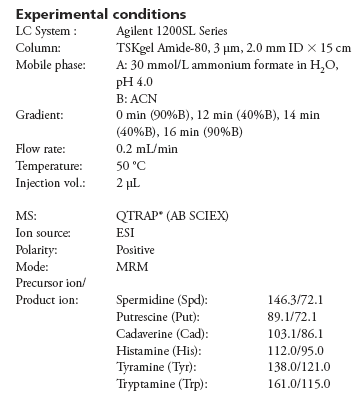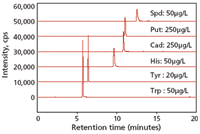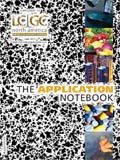Simultaneous and Direct Analysis of Biogenic Amines in Food by LC–MS-MS Using Hydrophilic Chromatography
Biogenic amines are present in protein-rich foods such as fish, meat, and milk. Their concentration increases during food decomposition.
Biogenic amines are present in protein-rich foods such as fish, meat, and milk. Their concentration increases during food decomposition. The reasons to monitor biogenic amines in food products are to determine that the food is suitable for consumption and to establish appropriate storage conditions. Analysis methods for biogenic amines include HPLC with fluorescence detection — using derivatization with dansyl chloride or o-phthalaldehyde. The drawbacks to these methods are a 40-min analysis time, sample pretreatment that requires fluorescence derivatization, and liquid phase extraction. In this study, we investigated a simple, highly sensitive, and direct analytical method that does not require derivatization and uses a TSKgel Amide-80 column under HILIC conditions followed by MS-MS detection (Figure 1).

Results and Discussion
Figure 2 and Table I detail the results of the analysis of six biogenic amines. Excellent separation of the analytes and linearity of the calibration curves were obtained. When compared to a fluorescence method using a reversed phase column (data not shown), this LC–MS-MS method can be completed in half the analysis time (20 min versus 40 min). The limits of quantitation for the analytes were 0.001–0.02 mg in a 100 g sample, an improvement of 5–1300 times compared with the fluorescence method.

Figure 1: Sample pretreatment procedure of LCâMS-MS method.
A study was conducted to compare the LC–MS-MS method to the fluorescence method in the evaluation of tuna samples under differing storage conditions. Table II lists the quantitative values of biogenic amines in tuna preserved for two days at freezing and room temperatures. Good correlation was obtained between the two methods.

Figure 2: Chromatograms of biogenic amines.
Conclusions
A new LC–MS-MS method for the analysis of biogenic amines was investigated by Tosoh scientists. Six biogenic amines were analyzed in 15 min under HILIC conditions using a TSKgel Amide-80 column without the need for a complex and time-consuming derivatization procedure. Limits of quantitation of the analytes were improved 5–1300 times using this new method compared with the conventional fluorescence method. Since good correlation between the two methods was obtained in a comparative study of quantitative values, the LC–MS-MS method is a proven alternative method that is both simple and sensitive for the analysis of biogenic amines in food products.

Table I: Comparison of limit of detection and quantitation values (LCâMS-MS versus fluorescence method)

Table II: Comparison of quantitative values of biogenic amines in tuna sample (mg/100 g)
Tosoh Bioscience and TSKgel are registered trademarks of Tosoh Corporation.
QTrap is a registered trademark of Applied Biosystems/MDS SCIEX Instruments MDS Inc.
Tosoh Bioscience LLC
3604 Horizon Drive, Suite 100, King of Prussia, PA 19406
tel. (484) 805-1219, fax (610) 272-3028
Website: www.tosohbioscience.com

New Study Reviews Chromatography Methods for Flavonoid Analysis
April 21st 2025Flavonoids are widely used metabolites that carry out various functions in different industries, such as food and cosmetics. Detecting, separating, and quantifying them in fruit species can be a complicated process.
Analytical Challenges in Measuring Migration from Food Contact Materials
November 2nd 2015Food contact materials contain low molecular weight additives and processing aids which can migrate into foods leading to trace levels of contamination. Food safety is ensured through regulations, comprising compositional controls and migration limits, which present a significant analytical challenge to the food industry to ensure compliance and demonstrate due diligence. Of the various analytical approaches, LC-MS/MS has proved to be an essential tool in monitoring migration of target compounds into foods, and more sophisticated approaches such as LC-high resolution MS (Orbitrap) are being increasingly used for untargeted analysis to monitor non-intentionally added substances. This podcast will provide an overview to this area, illustrated with various applications showing current approaches being employed.

.png&w=3840&q=75)

.png&w=3840&q=75)



.png&w=3840&q=75)



.png&w=3840&q=75)
















